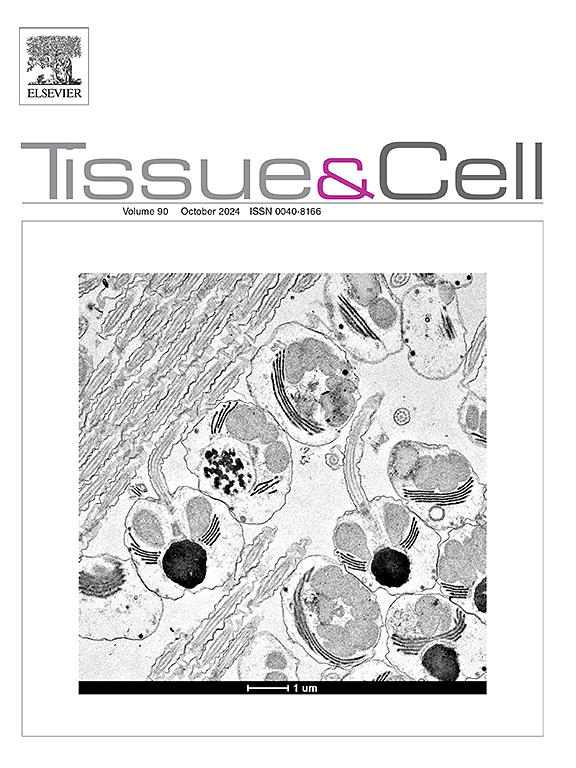MAZ通过转录抑制PPP3CA激活ERK/MAPK信号,促进破骨细胞发生和骨质疏松进展:功能和机制
IF 2.7
4区 生物学
Q1 ANATOMY & MORPHOLOGY
引用次数: 0
摘要
骨质疏松症(OP)是一种系统性骨骼疾病,可导致骨强度降低和骨折风险增加。本文探讨了蛋白磷酸酶3催化亚基α (PPP3CA)在OP中的作用及其机制。方法采用生物信息学预测方法,鉴定与OP相关的基因及其转录因子。采用卵巢切除术(OVX)建立了OP小鼠模型。采用RANKL诱导RAW264.7细胞向破骨细胞分化进行体外实验。结果sppp3ca在ovx诱导小鼠股骨组织中表达较低。PPP3CA的过表达降低活化T细胞核因子c1 (NFATC1)和基质金属蛋白酶9 (MMP9)水平和细胞外信号调节蛋白激酶(ERK)1/2磷酸化程度。PPP3CA过表达抑制破骨细胞分化和OP进展。myc相关锌指蛋白(Myc-associated zinc finger protein, MAZ)在ovx诱导小鼠股骨组织中高表达,并通过结合PPP3CA的启动子抑制PPP3CA的转录。MAZ促进ERK/丝裂原活化蛋白激酶(MAPK)通路,从而促进破骨细胞的发生。动物实验进一步证实MAZ/PPP3CA轴在体内通过ERK/MAPK通路促进破骨细胞的发生。结论maz通过抑制PPP3CA转录激活ERK/MAPK信号通路,促进破骨细胞的发生和OP的进展。这些发现不仅阐明了驱动破骨细胞发生的新机制,而且强调了MAZ/PPP3CA/ERK-MAPK轴是抑制骨吸收并最终改善OP治疗结果的创新疗法的有希望的靶点。本文章由计算机程序翻译,如有差异,请以英文原文为准。
Activation of ERK/MAPK signaling by MAZ through transcriptional repression of PPP3CA to promote osteoclastogenesis and osteoporosis progression: Functions and mechanisms
Objective
Osteoporosis (OP) is a systemic skeletal disease that contributes to compromised bone strength and increased fracture risk. This paper investigates the functional role of protein phosphatase 3 catalytic subunit α (PPP3CA) in OP and its mechanisms.
Methods
Bioinformatics prediction analysis was performed to identify genes associated with OP and its transcription factor. An OP mouse model was constructed by ovariectomy (OVX). RAW264.7 cells were induced to differentiate into osteoclasts using RANKL for in vitro experiments.
Results
PPP3CA was poorly expressed in the femoral tissues of OVX-induced mice. Overexpression of PPP3CA reduced nuclear factor of activated T cells c1 (NFATC1) and matrix metalloproteinase 9 (MMP9) levels and the extent of extracellular signal-regulated protein kinase (ERK)1/2 phosphorylation. Overexpression of PPP3CA inhibited osteoclast differentiation and OP progression. Myc-associated zinc finger protein (MAZ) was highly expressed in the femoral tissues of OVX-induced mice and inhibited the transcription of PPP3CA by binding to its promoter. MAZ promoted the ERK/mitogen-activated protein kinase (MAPK) pathway and thus promoted osteoclastogenesis. Animal experiments further demonstrated that the MAZ/PPP3CA axis promoted osteoclastogenesis through the ERK/MAPK pathway in vivo.
Conclusion
MAZ promotes osteoclastogenesis and OP progression by activating the ERK/MAPK signaling pathway through transcriptional inhibition of PPP3CA. These findings not only elucidate a novel mechanism driving osteoclastogenesis but also highlight the MAZ/PPP3CA/ERK-MAPK axis as a promising target for innovative therapies aimed at curbing bone resorption and ultimately improving treatment outcomes in OP.
求助全文
通过发布文献求助,成功后即可免费获取论文全文。
去求助
来源期刊

Tissue & cell
医学-解剖学与形态学
CiteScore
3.90
自引率
0.00%
发文量
234
期刊介绍:
Tissue and Cell is devoted to original research on the organization of cells, subcellular and extracellular components at all levels, including the grouping and interrelations of cells in tissues and organs. The journal encourages submission of ultrastructural studies that provide novel insights into structure, function and physiology of cells and tissues, in health and disease. Bioengineering and stem cells studies focused on the description of morphological and/or histological data are also welcomed.
Studies investigating the effect of compounds and/or substances on structure of cells and tissues are generally outside the scope of this journal. For consideration, studies should contain a clear rationale on the use of (a) given substance(s), have a compelling morphological and structural focus and present novel incremental findings from previous literature.
 求助内容:
求助内容: 应助结果提醒方式:
应助结果提醒方式:


